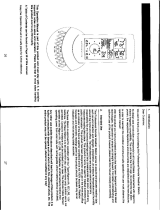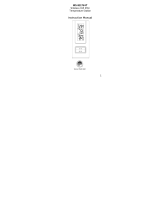Page is loading ...

WS-9080U-IT
915 MHz WIRELESS TEMPERATURE STATION
Instruction manual

Contents
Language Page
___________________________________________________________________
English 1
French 41
Spanish 79
1

2
TABLE OF CONTENTS
Topic Page
Inventory of Contents 3
Features 4
Setting Up 6
Battery Installation 10
Function Keys 12
LCD Screen and Settings 14
Atomic Time -WWVB Radio Controlled Time 16
Manual Settings 17
Display of Indoor Temperature Reading 25
Display of Outdoor Temperature Reading 26
Display of Indoor Minimum and Maximum records 26
Display of Outdoor Minimum and Maximum records 28
Daily Indoor Minimum and Maximum Temperature display 29
Daily Outdoor Minimum and Maximum Temperature display 30
915 MHz Reception 31
Mounting 32
Care and Maintenance 34
Specifications 35
Warranty 36

INSTANT TRANSMISSION is the state-of-the-art new
wireless transmission technology, exclusively
designed and developed by LA CROSSE
TECHNOLOGY. INSTANT TRANSMISSION offers you
an immediate update (every 4 seconds!) of all your
outdoor data measured from the sensors: follow your
climatic variations in real-time!
This product offers:
INVENTORY OF CONTENTS
1. Wireless Temperature Station
2. Wireless Temperature Sensor (TX29U) and mounting bracket.
3. Instruction Manual and Warranty Card.
3

FEATURES:
4
The Temperature Station
Foldout
Stand
Battery
compartment
cover
Function
Keys
LCD
Display
Hanging hole

5
• Atomic Time function (WWVB Radio controlled time) or manual time setting options
• Atomic Time reception On/Off
• Daylight Saving Time ON/OFF
• 12/24 hour display
• Hour and minute display
• Calendar display
• Time zone option ±12 hours
• Wireless transmission at 915 MHz
• Outdoor signal reception intervals at 4-second
• Temperature display in degrees Fahrenheit (°F) or Celsius (°C) selectable
• Indoor and Outdoor temperature display with MIN/MAX recording (records can be
reset)
• Can receive up to 3 outdoor sensors
• Daily minimum and maximum indoor temperature display
• Daily minimum and maximum outdoor temperature display
• Low battery indicator
• LCD contrast adjustable
• Table standing/ Wall mounting

The Outdoor Temperature Sensor
• Remote transmission of outdoor temperature to
Temperature Station by 915 MHz
• Water-resistant casing
• Wall mounting case (Mount in a sheltered place. Avoid
direct rain and sunshine)
SETTING UP:
When one Sensor is used
1. First, insert the batteries into the temperature sensor. (see “Install and replace
batteries in the temperature sensor“).
2. Immediately after and within 30 seconds, insert the batteries into Temperature
Station (see “Install and replace batteries in the Temperature Station”). Once
the batteries are in place, all segments of the LCD will light up briefly. Following the
6

7
time as 12:00 and the indoor temperature will be displayed. If these are not
displayed after 60 seconds, remove the batteries and wait for at least 10 seconds
before reinserting them.
3. After inserting the batteries into the sensor, the Temperature Station will start
receiving data from the sensor. The outdoor temperature and the signal reception
icon should then be displayed on the Temperature Station. If this does not happen
after 5 minutes, the batteries will need to be removed from both units and reset from
step 1.
4. In order to ensure sufficient 915 MHz transmission however, there should be no more
than 330 feet (100 meters) between the final position of the Temperature Station and
the sensor (see notes on “Mounting” and “915 MHz Reception”).
5. Once the remote temperature has been received and displayed on the Temperature
Station, the WWVB time code reception is automatically started. This takes typically
between 3-5 minutes in good conditions—but may take up to 4 nights.
When more than one sensor is to be used
1. User shall remove all the batteries from the Temperature Station and sensors and
wait 60 seconds if setting has been done with one sensor before.
2. Insert the batteries to the first sensor.
3. Within 30 seconds of powering up the first sensor, insert the batteries into to the
Temperature Station. Once the batteries are in place, all segments of the LCD will

8
light up briefly. Following time as 12:00 and the indoor temperature will be displayed.
If they are not shown in LCD after 60 seconds, remove the batteries and wait for at
least 60 seconds before reinserting them.
4. The outdoor temperature from the first sensor (channel 1) should then be displayed
on the Temperature Station. Also, the signal reception icon will be displayed. If this
does not happen after 2 minutes, the batteries will need to be removed from both
units and reset from step 1.
5. Insert the battery into the second sensor immediately after (within 10 seconds after)
the reading form the first sensor is shown on LCD.
6. The outdoor temperature from the second sensor and the "channel 2" icon should
then be displayed on the Temperature Station. If this does not happen after 2 minute,
the batteries will need to be removed from all the units and reset from step 1.
7. Insert the batteries into the third sensor immediately after (within 10 seconds after)
ithe reading from the second sensor is shown on LCD.
8. Then within 2 minutes, the channel 3 outdoor data from the third sensor will be
displayed and the channel icon will shift back to "1" once the third sensor is
successfully received. If this is not happen, user shall restart the setting up from step
1.
9. In order to ensure sufficient 915 MHz transmission there should be a distance of no
more than 330 feet (100 meters) between the final position of the Temperature
Station and the sensor (see notes on “Mounting” and “915 MHz Reception”).

9
Note:
• Transmission problems will arise if the setting for additional sensors is not followed as
described above. Should transmission problems occur, it is necessary to remove the
batteries from all units and follow the set-up from step 1.
• If the signal reception is not successful on the first frequency (915MHz) for 45
seconds, the frequency is changed to 920MHz and the learning is tried for another 45
seconds. If still not successful the reception is tried for 45 seconds on 910MHz. This
will also be done for re-synchronization.
10. Once the remote temperature has been received and displayed on the Temperature
Station, the WWVB time code reception is automatically started. This takes typically
between 3-5 minutes in good conditions.
IMPORTANT:
• Transmission problems will arise if the setting for additional sensors is not followed as
described above. Should transmission problems occur, it is necessary to remove the
batteries from all units and follow the set-up from step 1.
• If after 10 minutes, the Atomic auto-set time (WWVB time) has not been received,
press the SET key to manually enter a time initially.
• Daily WWVB reception is attempted at full hour between 12:00 am to 6:00 am. If the

reception is successful, there will no reception attempt until the following day. When
this is successful, the received time will override the manually set time. The date is
also updated with the received time. (Please refer also to notes on “Atomic auto-set
time - WWVB Radio controlled Time” and “Manual Time Setting”).
BATTERY INSTALLATION
INSTALL AND REPLACE BATTERIES IN THE TEMPERATURE STATION
The Temperature Station uses 2 x AAA, IEC LR3, 1.5V batteries. To install and replace the
batteries, please follow the steps below:
1. Remove the cover at the back of the Temperature Station.
2. Insert batteries observing the correct polarity (see marking).
3. Replace compartment cover.
10

INSTALL AND REPLACE BATTERIES IN THE TEMPERATURE SENSOR
11
The temperature sensor uses 2 x AA, IEC LR6, 1.5V battery. To
install and replace the batteries, please follow the steps below:
1. Remove the battery compartment cover.
2. Insert the batteries, observing the correct polarity (see
marking).
3. Replace the battery cover on the unit.
Note:
In the event of changing batteries in any of the units, all units need to be reset by following
the setting up procedures. This is because a random security code is assigned by the
sensor at start-up and this code must be received and stored by the Temperature Station in
the first 3 minutes of power being supplied to it
BATTERY CHANGE:
It is recommended to replace the batteries in all units regularly to ensure optimum accuracy
of these units (Battery life see Specifications below).

12
Please participate in the preservation of the environment. Return used
batteries to an authorized depot.
FUNCTION KEYS:
Temperature Station:
The Temperature Station has four easy to use function keys.
SET key
MIN/
MAX key
+ key
CH/- key

13
SET key (Manual Setting):
• Press and hold to enter the setting mode for the following settings: LCD contrast,
Time zone, Daylight saving time ON/OFF, Atomic Time Reception (RCC) ON/OFF,
12/24 hr format, Manual time, Year, Month, Day and °C/°F settings.
MIN/ MAX key
• To toggle between the minimum/ maximum indoor and outdoor temperature records
• Press to exit the setting mode
• Press to reset the minimum and maximum or temperature records of the indoor and
the outdoor channel (will reset all records to current level)
+ key
• To make a "positive" adjustment for various settings
• In normal display, press to toggle between the display of the calendar data and
second of time in the time display of LCD
CH/- key
• To make a "negative" adjustment for various settings
• To toggle between different outdoor channel display (when more than 1 outdoor
sensor is adopted)

14
LCD SCREEN AND SETTINGS:
Indoor
Temperature
Time display
"Weekday + Day" or Day
+ Month" or "Second"
display
Receiver low
battery icon
Outdoor
Temperature
Time reception icon
Outdoor signal
reception icon*
Sensor low battery
icon
Daily indoor max
temp
Daily outdoor max
temp
Daily indoor
min temp
Channel No.
(Outdoor Sensor ID)
Daily outdoor
min temp

*When the outdoor signal is successfully received by the temperature station, this icon will
be switched on. (If not successful, the icon will not be shown in LCD) So user can easily
see whether the last reception was successful (icon on) or not (icon off). On the other hand,
the short blinking of the icon shows that a reception is currently taking place.
Note:
The Channel No. (Outdoor Sensor No.) will be shown when more than one outdoor sensor
is adopted.
For better distinctness the LCD screen is split into 3 sections displaying the information for
time and date, Indoor data and outdoor data.
Section 1 - TIME AND CALENDAR
• In normal mode, display the time and "weekday + day". Press the + key once to
display the "day + month"; twice to display the second of time.
• A signal reception symbol is shown indicating that Atomic auto-set time (WWVB
time) signal is received.
Section 2 - INDOOR TEMPERATURE
• Display current indoor temperature
• Display daily minimum and maximum indoor temperature
15

16
Section 3 - OUTDOOR TEMPERATURE
• Display current outdoor temp
• Display daily maximum and minimum outdoor temperature
ATOMIC TIME - WWVB RADIO CONTROLLED TIME
The NIST (National Institute of Standards and Technology—Time and Frequency Division)
WWVB radio station is located in Ft. Collins, Colorado, and transmits the exact time signal
continuously throughout the United States at 60 kHz. The signal can be received up to
2,000 miles away through the internal antenna in the Temperature Station. However, due to
the nature of the Earth’s Ionosphere, reception is very limited during daylight hours. The
wireless weather station will search for a signal every night when reception is best.
The WWVB radio station receives the time data from the NIST Atomic clock in Boulder,
Colorado. A team of atomic physicists is continually measuring every second, of every day,
to an accuracy of ten billionths of a second per day. These physicists have created an
international standard, measuring a second as 9,192,631,770 vibrations of a Cesium-133
atom in a vacuum. For more detail, visit http://www.boulder.nist.gov/timefreq.htm. To listen
to the NIST time, call (303)499-7111. This number will connect you to an automated time,
announced at the top of the minute in “Coordinated Universal Time”, which is also known
as Greenwich Mean Time (GMT). This time does not follow Daylight Saving Time changes.
After the top of the minute, a tone will sound for every second. It is possible that your

17
Wireless Temperature Station may not be exactly on the second due to the variance in the
quartz. However, the clock will adjust the quartz timing over the course of several days to
be very accurate; under 0.10 seconds per day.
MANUAL SETTINGS:
The following manual settings can be done in the setting mode:
• LCD Contrast setting
• Time zone setting
• Daylight Saving Time ON/OFF setting (DST)
• Atomic Time reception ON/OFF setting (RCC)
• 12/24 hour time format setting
• Manual time setting
• Calendar setting (Year, Month, Date)
• °F/ °C temperature unit setting
Press and hold the SET key for about 3 seconds to advance to the setting mode:

LCD CONTRAST SETTING
flashing
The LCD contrast can be set to 8 different levels (0 to 7) to suit the user’s needs (default
LCD contrast setting is LCD 4). To set the desired contrast level:
1. The above display will be seen. Press the + key or CH/- key to select the level of
contrast desired.
2. Press the SET key to confirm and enter the “Time Zone setting” or exit the setting
mode by pressing the MIN/MAX key
TIME ZONE SETTING:
flashing
18

The time zone default of the Temperature Station is -5 hr. To change to another time zone:
1. Using the + key or CH/- key, set the time zone. The range runs between -12 to +12
hour.
2. Press the SET key to confirm and enter the “Daylight Saving time ON/OFF setting”
or exit the setting mode by pressing the MIN/MAX key.
DAYLIGHT SAVING TIME ON/OFF SETTING
flashing
1. The digit “ON DST” will start flashing on the LCD.
2. Use the + key or CH/- key to turn On or OFF the daylight saving time function.
3. Confirm with the SET key and enter the “Time reception On/Off setting” or exit the setting
mode by pressing the MIN/MAX key.
19
/









